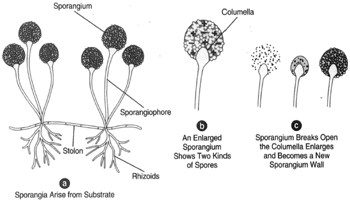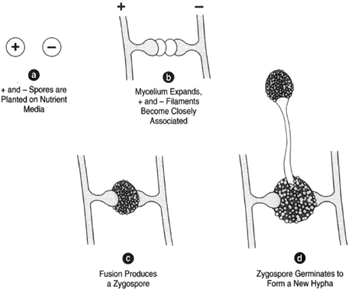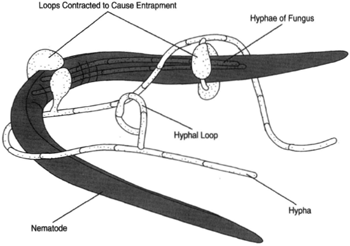Zygomycetes
There are no flagellated cells in Zygomycetes. Rather, there is an extensive coenocytic mycelium within the substrate as well as an aerial mycelium that produces sporangia. The walls are chitinous. Black bread mold (Rhizopus nigricans) is the most common form of Zygomycetes and demonstrates both the vegetative production of mitospores and a sexual process (called conjugation) whereby zygospores are produced. |
| Figure 18-3 A sexual reproduction in Rhizopus nigricans. (a) Sporangia arise from the substrate. (b) An enlarged sporangium showing two kinds of spores: plus and minus. (c) When a sporangium breaks open, the columella enlarges and becomes a new sporangium wall. A new columella is then produced. |
If a piece of bread is placed in a moist container, a cottony, white mycelium will soon grow throughout the substance. Rootlike haustoria penetrate the substrate while the upright hyphae send sporangiophores upward. When sporangia are produced, the entire mass becomes black. As the sporangia enlarge, cross walls form, thus separating the sporangium from the rest of the mycelium. Such a cross wall is called a columella. Thceo ntents of the sporangium form a largne umber of uninucleate mitospores. Ther upture of the sporangium wall releases the spores. The columella then expands, forming a new sporangium wall. Additional nuclei then move into the new sporangium, and a new columella is made. In this manner, a series of sporangia form and rupture at the end of a single sporangiophore
 |
| Figure 18-4 Sexual reproduction in Rhizopus nigricans. (a) Plus and minus spores are planted on a nutrient medium. (b) The mycelium expands, and plus and minus filaments become closely associated. (c) Fusion produces a zygospore, which can germinate to produce a new hypha. (d), The first divisions of the zygote nucleus are meiotic. |
Sexual reproduction requires that mating types of Rhizopus grow near each other. The fungus is heterothallic. When a hypha of a plus (+) strain grows close.to a hypha of a minus (−) strain, projections grow out from the hyphae and come in contact with each other. The nuclei of the plus and minus strains fuse to produce a diploid zygospore, which develops a hardened outer covering and is able to remain dormant for some time. Upon germination, meiosis takes place, and the haploid condition is restored.
Some members of Zygomycetes grow as parasites on protozoa and other small creatures. The fungus develops hyphae in the body of the host, where it can absorb nutrients. There is also a soil-dwelling form that captures microscopically sized roundworms in hyphal loops. If a nematode were to swim through a loop, the loop would suddenly clamp down on the worm, hold it, and produce haustoria (which would, in turn, grow through the worm’s body). When such fungi are grown in the laboratory, they do not produce loops unless nematodes are placed in the growth medium.
 |
| Figure 16-5 A nematode-trapping, carnivorous fungus. |




